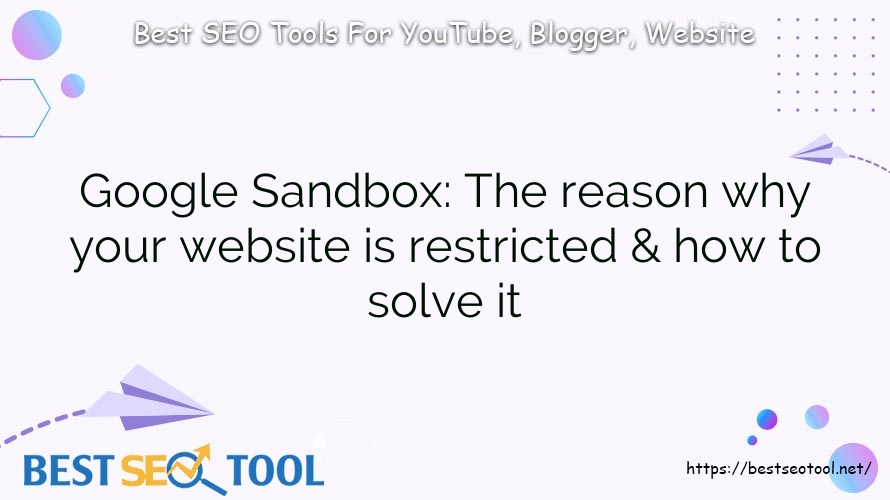SEO Basic, SEO Tutorial
Google Sandbox: The reason why your website is restricted & how to solve it
Google Sandbox is a phenomenon that the SEO world often mentions when SEO on a new website; or when SEO a new keyword phrase. It’s like a time when Google challenges any new website. Prevent the website from appearing in the search results.
Even if you do everything well, your website will not achieve the desired rankings until that stage is over.
However, this Sandbox phenomenon Google has never confirmed. However, most SEOers still believe in its existence. And they noticed some signs like the sandbox described when embarking on new web SEO.
So, is the Google Sandbox clamp present in 2022? If so, what do you do to prevent Google from sandboxing your site?
This article is just for you; Beginners to create and prepare to SEO for a new website. Or for those who are suspecting that your website has been sandboxed in the past few months, because of the failure in your keyword choices.
What is Google Sandbox
Back in 2004, when most webmasters and SEOers realized that during the first few months, despite their best efforts to optimize the SEO process standards on newly launched websites, they still couldn’t get to a high position in google rankings
These websites stay out of the top 100 on Google even though SEO on keywords with low competition. Although on other search engines like Bing or Yahoo, they already rank high. They found this phenomenon (sandbox) lasted from a few weeks to several months.
Surely you also know that Google’s goal is to return the results that best match the user’s needs, right? That’s why when Google doesn’t trust new websites. It makes sense to temporarily suppress them from appearing.
The Discovery of Google Sandbox in SEO
Rand Fishkin, Co-founder of Moz has also revealed that Google has placed a sandbox on the MOZ website; somewhere for 9 months. Although they have optimized SEO for MOZ website by whitehat methods.

In 2014, there was another big upheaval from the Google sandbox when SEOers and website owners thought that their new sites weren’t ranking as fast as they used to.
The Google algorithm has greatly improved, to prevent more intense spam.
So in 2018, how is the sandbox phenomenon? If so, how long will it last?
The truth about Google Sandbox in 2022
Personally, I have met many SEOers who say that their website has only been established for a month but has quickly ranked high. However, they still feel that something is preventing their website from ranking higher.
As I said above, the reason Google didn’t rank those new sites is simply because they want to spend more time evaluating quality and minimizing spammers.

Furthermore, we all know that backlinks are one of the most important ranking factors. Of course, new websites will hardly have strong backlinks within a few weeks?
Besides, this Google also has an artificial intelligence Rank Brain that continuously measures and considers user behavior through CTR rate, Time Onsite, and other metrics to decide the ranking order.
However, you don’t always see a Google sandbox for any new website, because there are also cases where Google will put new content on the top to test whether they meet the user’s wishes or not through the track visitor behavior.
For example in the following case:
Did you see the first traffic peak in the picture below? That’s when Google was testing the new site.

Many SEOers are happy to see their new website on the top right away. After a few days, it disappeared. Simply put, the Google test is done, the current rank of the keyword is the correct rank
Fact: Google does not recognize sandboxes
In all official statements, Google has never recognized the Sandbox algorithm

Even though Google doesn’t officially acknowledge sandboxing. But just think about it, if you were Google when a new website appears, you probably don’t want to give it a high ranking in the search results too.
T.T.T – The curse of the Google Sandbox
At the last Entity Building 3.0 session, I introduced you to 3 main pillars in SEO, which are the 3 Ts, respectively: Trust (reputation) – Traffic (interaction) – Theme (relevance), or Thematic. These are the three things Google wants to see in you. With a website that has only been built for a few months, most of these 3 elements are missing. Specifically, I list them here for your attention:
Lack of relevance & expertise (Theme)
Think about it
Google needs top-quality content in the search results, and above all, it must see your website as an “expert” in the field, a website that addresses, speaks, conveys, and answers many aspects of users. use.
I mean, if I want to trust someone with high expertise in SEO, they have to be knowledgeable about many aspects of the field such as Google Panda, Google Penguin, Backlinks, Content, Onpage optimization, Page Rank, Trust Rank, …
Similarly, Google also needs to see the content on your website, but google doesn’t want content like SEO service in district 1, SEO service in district 2, SEO service in district 3, SEO service in district 4, translation cheap SEO service, …
What is your solution here?
Simply create Semantic and Thematic content!.
Semantic content contains semantic keywords that make it easier for Google to understand what your website is talking about and give you an SEO score more easily, and Thematic Content is a collection of much Sematic content.
If you don’t know specifically about semantic content and how to create them, watch my technical video for finding semantic keywords within 10 minutes:
Lack of user signal (Traffic)
As I mentioned above, many SEOers believe that CTR, bounce rate, and dwell time are among the ranking factors. Google needs to see user interaction on your website (here at least website traffic) to trust that your site is useful to users.
Your solution:
Use phantom keywords – keywords that are forgotten by competitors without SEO and have a lot of searches.

Each article that includes phantom keywords will be able to get to the top very easily even if you are a new website. Because, in phantom articles, the competition is very little, and if your content is better than your competitors, you can easily rank high.
Combining ideas 1 and 2 here, you have themed articles (semantic content) to clarify the meaning of your website. Surely you will achieve 2 T’s, Theme & Traffic.
Lack of quality links (Trust)
Links along with content and RankBrain are among the three most important ranking factors. And links include the following types of links: internal link (internal link), out-link (link pointing out), and backlink (link pointing back).
In the two elements internal link and out-link, you can actively build them according to step 2 I mentioned above.
As for backlinks, if a website is newly created, then naturally there will be few reputable quality backlinks pointing to it, or if so, weak backlinks do not have enough “link juice” to transmit power to you.

Be careful with the number of backlinks increasing too quickly in a suspicious way. Next is the over-optimized main SEO keyword anchor text. They could be the reason why you got penalized by Google.
Competitive keywords in different markets
As you probably already know, Google’s ranking algorithm is not the same in all markets. But Google has deliberately made it different between different industries and niches.
This is not the kind of universal ranking algorithm that can be applied to all cases.
So this Google sandbox phenomenon is completely different according to different industries. For example, medical and legal websites are sandboxed longer than other industries.
That’s because these websites have a great influence on people’s lives; The content on such sites should be taken seriously.
How to cancel or shorten the Google sandbox time?
According to the experience of Bill Sebald – a global SEO expert, it is completely possible. I checked the Sparktoro.com website by showing a screenshot From Ahrefs showing the number of backlinks of this website.
Here is the number of organic keywords and the amount of search traffic to the website:
Overall, the statistics on both charts are impressive!
But if you take a closer look. You’ll see that Sparktoro doesn’t rank for any of the top 10 heavyweight keywords (except for brand keywords).
So what should I do in the face of Google Sandbox?
We can completely circumvent the effects of this google sandbox. If a site goes viral (widespread virality) and is getting a few hundred to 1 thousand daily traffic. Active on social media and get quality backlinks. Then that website will immediately be brought into the eyes of Google. I’ve seen this happen twice so far with brand newbrand-new sites. Even the ones that rank #1 for their top keywords.
The establishment of a brand. Or a new website is a great opportunity for you to do better PR or link building. One of those ways is Entity. As mentioned above…
Conclusion
I hope you have somewhat understood what a sandbox is. As well as how to fix when the website is sandboxed!
Sandbox is indeed a big barrier for new websites. Although Google has never made any official announcement about this phenomenon. But naturally, Google is inherently not very trusting of newly established websites!
However, those who are just starting to create and prepare for SEO for a new website. It is still possible to break or shorten the sandbox time by improving the following 4 main factors: content, traffic, trust, and also competitive keywords in different markets. From there, the website may have the opportunity to immediately catch Google’s eyes.
Good luck!


